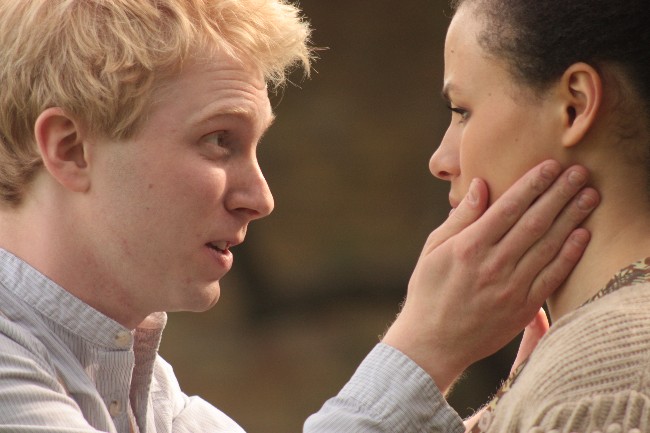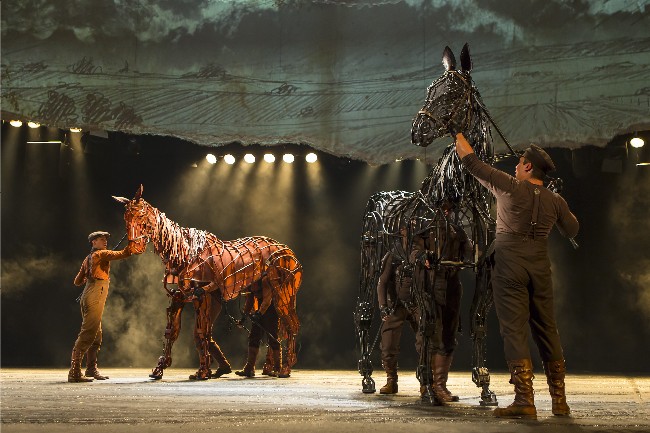Theater Review: Two Theatrical War Horses Come To Town
Two warhorses of the theater come to town: Shakespeare’s Hamlet trots along in the Globe Theatre touring production, while War Horse shows off the equine puppet body beautiful.
War Horse. Based on the novel by Michael Morpurgo. Adapted for the stage by Nick Stafford in association with Handspring Puppet Company. Directed by Bijan Sheibani. Codirected by Marianne Elliott and Tom Morris. Sets, costumes, and drawings by Rae Smith. Puppet design, fabrication, and direction by Adrian Kohler with Basil Jones for Handspring Puppet Company. Original lighting by Paule Constable. Additional lighting and adaptation by Karen Spahn. Director of movement and horse choreography by Toby Sedgwick. Staged by the National Theatre of Great Britain in association with Handspring Puppet Company. Presented by Broadway in Boston at the Boston Opera House, Boston, MA, through October 21.
Hamlet by William Shakespeare. Directed by Dominic Dromgoole and Bill Buckhurst. Sets and costumes by Jonathan Fensom. Original score by Laura Forrest-Hay. Composer/arranger by Bill Barclay. Lights by Paul Russell. Choreography by Siân Williams. Fight direction by Kevin McCurdy. Staged by Shakespeare’s Globe Theatre of London. Presented by ArtsEmerson at the Paramount Center Mainstage, Boston, MA, through October 21.
By Bill Marx

All together now: Joey and the cast of the US touring production of WAR HORSE. Photo: Brinkhoff/Mögenburg
War Horse and the Shakespearean war horse Hamlet have an extraordinary amount of poetry in their bones, which is one reason they stick around. I am not confident that the former will be staged hundreds of years from now, but as someone who tears up at the mere mention of Old Yeller, I am not betting against it.
In War Horse, the lyricism is in the puppetry. The miraculous creations of Adrian Kohler and Basil Jones (of the Handspring Puppet Company) are manipulated by a trio of nimble puppeteers who perform dance-like movements in the service of capturing the essence of equine movement and sound. Horses haven’t made such a powerful appearance in downtown Boston theater since real specimens were trotted out for the climactic chariot race at the end of turn-of-the-century productions of Ben Hur. (And yes, I am including Equus).
For those who love puppets, as I do, the touring production of War Horse is required viewing—the animation of such beautifully made, inanimate objects (fashioned out of aluminum and cane) not only generates visual poignancy but an admiration for the skilled manipulations of puppeteers who perfect their magic by disappearing behind the indelible impression of the animals they create. The horses range from the heroic Joey as a foal and a chestnut adult to the midnight black giant Topthorn and two snowy horses teetering near death, fabulously skeletal creations that are worthy of a race course run by Samuel Beckett. Add in a wheelie goose and assorted birds, including carrion fowl, and you have delightful assortment of man-made creatures.
The most powerful part of the show, for me, are the early scenes when the frightened foal develops a relationship with his young owner, the gentle farm boy Albert Narracott. The initial wary give-and-take is wonderfully pantomimed, giving way to the eventual establishment of trust between the young horse and his amiable master via a choreography punctuated with snorts and whistles. Since this is Devon shortly before World War I, the rest of the production moves into less nuanced territory, with Joey sold into military service by Albert’s dependably (mainly for the sake of the plot) weak-minded father. The teen soon joins up, venturing into no-man’s-land in order to bring his beloved animal home.
From then on War Horse makes the cliff-hanger experiences of The Perils of Pauline look like child’s play—Michael Morpurgo’s source novel (and Nick Stafford’s adaptation) put Albert and Joey into continual peril, to the point of fatigue. (It is easy to see why Steven Spielberg made a 2011 film version of the material—Joey is ET in the trenches.) I began to weary of the ham-fisted emotional manipulation right around the time the poor, put-upon horse, now in German hands, is hitched up to a giant gun, maybe Big Bertha, and is told to “pull us out of this hell.” No such luck I am afraid (running headlong into snaky coils of barbed wire is yet to come), which is why the reunion scene, which should have been a tear-wringing powerhouse, paled besides the sensitive opening moments, when puppet and man create such an affecting picture of the art of nurturing.
War Horse has won a slew of major awards on both sides of the Atlantic—the reason to see this touring production, with its straightforward performances, sturdy stereotypes, and agile use of video-as-backdrop, is to appreciate the prestidigitation of the puppetry.
With its harrowing episodes of death and destruction during World War I, War Horse provides plenty of grisly horror. It says all you need to know about Shakespeare’s Globe Theatre’s pedestrian touring production of Hamlet that it does away with the play’s macabre thrills. The most innovative thing about this staging is that its directors (Dominic Dromgoole and Bill Buckhurst) have come up with the most matter-of-fact presentation of the opening ghost scenes I have ever seen. Usually there is some attempt to suggest the presence of the extraordinary—askew lighting, disconcerting music, the shudders of the guards and Horacio. Granted, those spooky approaches have degenerated into clichés. But here Hamlet’s father wonders on and off the stage as if he was a weird next door neighbor asking for a cup of sugar. The prosaic takes the place of the preternatural.
The opening is the tip-off. The question regarding any production of Hamlet is whether the Bard’s notoriously knotty poetry and knockabout revenge plot will be wrestled with seriously or simply skimmed over. This is Hamlet lite, tragedy as not all that much out of the ordinary, a fast-moving, “classic” entertainment (relax nervous theatergoers, no heavy lifting) that includes the cast singing ballads at the beginning and end of the production to assure us that this isn’t the ‘downer’ of yore, a minimalist approach to costumes and set that is undeniably efficient but homogenizes the action, and double quick-tongued delivery of the verse that has the actors accenting just about every noun in each line to make sure we ‘get’ it. Because the obvious point is always hammered home hard, there is no effort to shed fresh or unexpected light on a line, to invent an unexpected, revelatory bit of business.
There are some ingenious staging decisions — such as the instant back-and-forth between the play-within-the-play and the court’s reactions. But the dumb show itself is mined campy laughs. Apparently, this Hamlet is a complete theatrical amateur: he has not come up with an experience designed to ‘catch the conscience of the king’ but to tickle his funny bone.

Michael Benz (Hamlet) and Carlyss Peer (Ophelia) in the Globe Theatre’s HAMLET. Photo: Fiona Moorehead
Thus the Globe Theatre’s Hamlet moves along with dispatch, but there isn’t all that much at stake either dramatically or thematically. Michael Benz’s blond Hamlet comes off as a zany adolescent who wises up too late, Miranda Foster’s Gertrude and Dickson Tyrrell’s Claudius are hapless, suburban parents who don’t know what to do with their problem child. The most promising voice and presence in the production belongs to Carlyss Peer as Ophelia—she is more dutiful than sexually akimbo, but the actress occasionally takes her time with the verse. The eight cast members play a number of characters, sometimes to amusing effect (Foster is not only the Player Queen but the Second Gravedigger), but unlike the puppeteers in War Horse they do not disappear into their roles.
Pitched at fast ball speed, this Hamlet has been engineered to get the proceedings over the plate painlessly in 2 hours and 30 minutes. Still, the lickety-split playfulness of this staging has impressed many area critics, so I guess the value of the Globe Theatre production depends on how you understand Hamlet. Take away its mystery and difficulty, its invitation to baffle and disturb and, for me, you discard the monumental tragedy’s dark power as well as its poetry. But for others, such as the WBUR reviewer, “the entertainment values are so sharp you want to get up and dance a jig.” Polonius couldn’t have said it better.
Note: For those who enjoy War Horse, I would highly recommend John Hawkes’ 1993 novel Sweet William: The Memoir of an Old Horse, a beautifully written, picturesque year of tragedy and muted triumph told from the witty, wised-up point-of-view of the title beast. Here is a humane anthropomorphic tale that doesn’t marginalize tenderness amid its Dickensian trials and tribulations.
Bill Marx is the editor-in-chief of The Arts Fuse. For over three decades, he has written about arts and culture for print, broadcast, and online. He has regularly reviewed theater for National Public Radio Station WBUR and The Boston Globe. He created and edited WBUR Online Arts, a cultural webzine that in 2004 won an Online Journalism Award for Specialty Journalism. In 2007 he created The Arts Fuse, an online magazine dedicated to covering arts and culture in Boston and throughout New England.
Tagged: Broadway in Boston, Hamlet, Puppets, Shakespeare, Shakespeare's Globe Theatre

